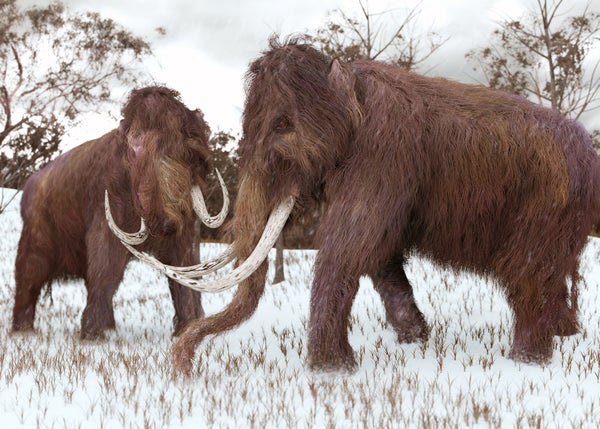Mainland mammoths—once common in North America and Siberia—were done in as a species by a warming climate and human hunters some 10,000 years ago. Scattered smaller populations, on islands without predators, lasted another 6,000 years. Yet as a new study reveals, the last mammoths to inhabit Earth had a rather awkward evolutionary denouement—one that could serve as a guide to conservationists working to rescue dwindling species, and to those looking to bring back the mammoth itself.
The new work, published Thursday in PLoS Genetics, compares the genomes from two unearthed woolly mammoths—one from mainland Siberia dating back 45,000 years and another just 4,300 years old from Wrangel Island, a barren, Delaware-size rock north of Siberia and the last known mammoth refuge. The authors report the final mammoths underwent a “genetic meltdown” ahead of their extinction, meaning their genomes were wrought with harmful mutations that did not do them any social or sexual favors.
Two such mutations gave their famously shaggy coats a bizarre, satinlike translucence; other mutations impaired their sense of smell and caused stomach irritation; and still more genetic blips hindered production proteins in their urine that scientists know—thanks to research on Indian elephants, the mammoth’s closest existing relative—can make or break a courtship (and also throw off social strata) among the Elephantidae family.
On supporting science journalism
If you're enjoying this article, consider supporting our award-winning journalism by subscribing. By purchasing a subscription you are helping to ensure the future of impactful stories about the discoveries and ideas shaping our world today.
The new findings support theoretical mathematical models suggesting that as any animal population decreases in size, it can experience a genomic deterioration; natural selection becomes inefficient and bad mutations that would normally be weeded out end up sticking around, simply because there are fewer genetic variants from which to select. “This study was very interesting because it let us look at a snapshot of 'before' and 'after' a change in population size within a single species,” says study co-author and University of North Carolina at Charlotte bioinformatics and genomics professor Rebekah Rogers. “In the Wrangel Island mammoth we see a massive excess of what appear to be bad mutations. It’s difficult to catch a population in the process of going extinct, but this study finally made it possible, thanks to advances in DNA sequencing.”
Rogers admits that she and her collaborator Montgomery Slatkin—a noted University of California, Berkeley, biologist who has long studied the genomics of population size—are not certain whether or not the bad mutations directly led to mammoth extinction. Yet she believes they did not help the increasingly isolated megafauna adapt to a changing environment.
The new findings may have sobering implications on conservation efforts. Rescuing a small, isolated community of a particular endangered species could propagate the bad genes that result from inbreeding and genomic meltdown: a species replenished, yet stricken with illness. Swedish Museum of Natural History biologist Love Dalén, who was not directly involved in Rogers and Slatkin’s research, adds, “The finding that genomic deletions may increase in declining populations is something that has been generally overlooked in conservation biology. If this is a general pattern in other species, it would constitute an additive threat to the genetic health of threatened species.”
Rogers explains that the longer a population remains small, the more potentially bad mutations it will acquire—and even if a species is restored to adequate numbers, its collective genome will still bear the scars of mutation meltdown. Yet, she adds, mathematical simulations suggest it took hundreds of generations for the Wrangle Island mammoths to accumulate their harmful mutations. Given that so many species have only landed on the endangered species list relatively recently, perhaps there is hope that some species can be salvaged with their genomes intact.
Rogers is quick to acknowledge her indebtedness to Dalén who originally sequenced the mammoths used in the new study and in 2015 publicly released their genome sequences. Dalen also lent his data to another biological pursuit—one of epic and ethically loaded ambition, and whose name speaks for itself: the Woolly Mammoth Revival project.
Frequent news fodder, this joint effort led by Harvard geneticist George Church entails using genetic-engineering techniques to bring back the mammoth—or, more accurately, to produce a more mammothlike elephant—and repopulate remote areas of Earth; in other words to bring about “de-extinction.” So far the research team has successfully used CRISPR–Cas gene-editing technology to splice mammoth genes into living elephant cells, and Church foresees cloning attempts as early as 2018. (Somewhere a surrogate elephant mom, or perhaps an artificial womb, lays in wait.)
Questions of whether or not humans should bring back the woolly mammoth aside, the new findings present a new problem, lest we revive a sickly beast. “My biggest concern with mammoth de-extinction are the ethical implications,” Rogers worries. “Elephants are extremely intelligent and social. They have a capacity for suffering similar to our own. If a detrimental mutation was put into the DNA, the implications for the elephant’s quality of life could be serious.” Yet given her respect and admiration for Church and his work, she is confident his group will take care to avoid any detrimental DNA.
Dalén agrees that any further de-extinction efforts should take the new findings into account, because introducing genes from an animal on the “brink of extinction” could result in serious health problems. “I don't know if [Church’s group] is planning to use the Wrangel genome,” he jokes. “But if so, they could be in for some surprises—possibly satin-colored surprises with gastric irritation.”
